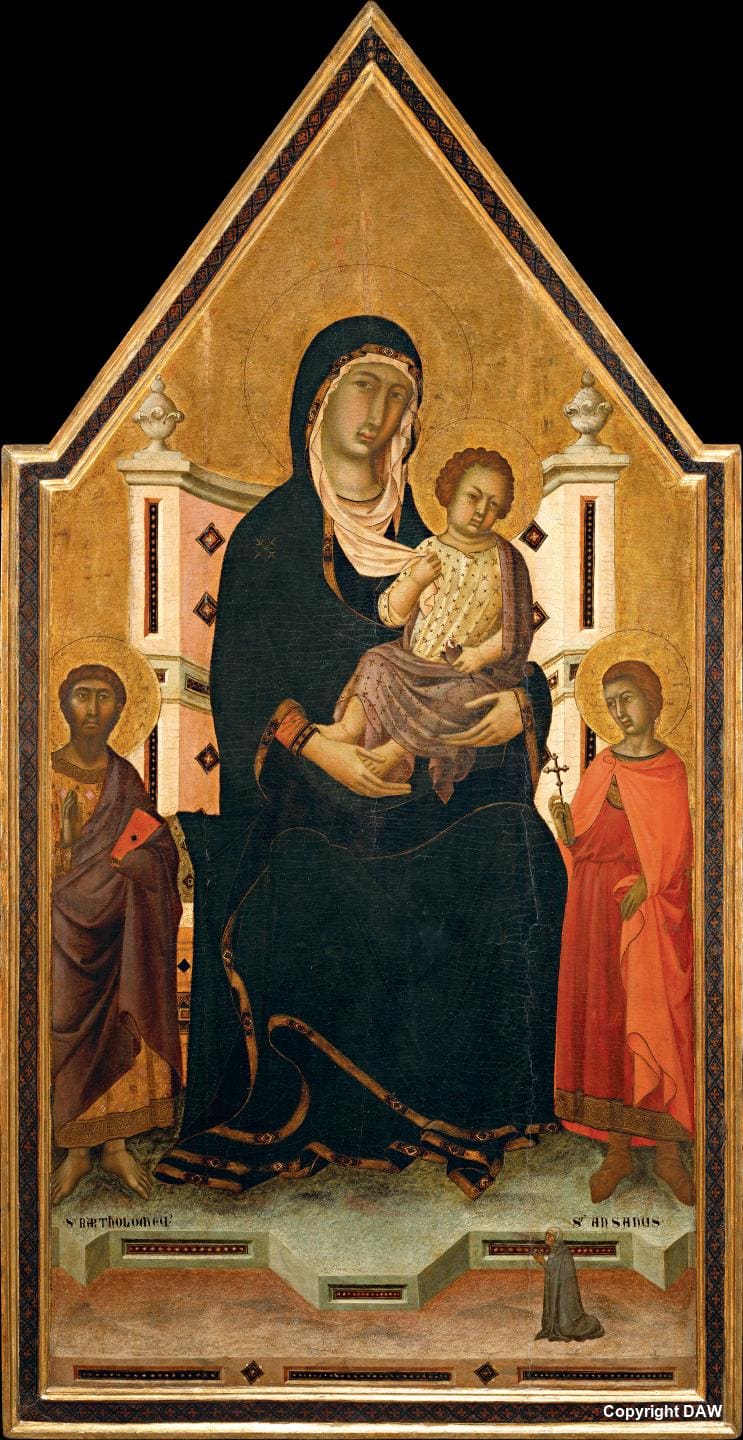Artwork Details
The panel was originally a part of an altarpiece.
The painting depicts Madonna with Child sitting on the throne with two saints on the sides; on the right there is St. Ansanus, one of the four patron saints of Siena, wearing a red mantle and holding a cross in his hand, while on the left there is St. Bartholomew wearing a large dark cloak over a richly decorated garment and holding a book which is partly covered by his mantle.
Their names are engraved on their feet. In the foreground on the right there is the donor in much smaller size compared to the two saints. She is kneeling with her hands clasped in prayer and wearing a large purple dress.
The background of the panel is completely gilded.
Although the composition is simple the painter shows knowledge of the novelties of Sienese painting by Simone Martini and Ugolino di Nerio, which can be seen in Mary’s gentle facial features, in Child’s natural gesture pulling the veil of his mother and in the decoration of the throne, which is similar to his Maestà in Castelfiorentino.
The painting dates between 1318 – 1325.
Before 1924 the painting was at Bonvini in Florence and then it passed to Bondi collection, where it was registered in that same year. In 1937 the painting was in San Domenico in Fiesole, in the villa della Luna of Luigi Pisa. He sold the painting in 1938 to the Artistic Circle of Venice. The following year Alfredo Geri sold the work with the attribution to Segna di Bonaventura. The painting was sent to the Philippines for a long period, until in 1991 it was sold in Christie’s of New York and the painting returned to Florence once again. The painting was sold to other owners various times until Fondazione Monte dei Paschi di Siena acquired the work at Christie’s in London on 2 December 2008.
Artist Details
View All From Artist
Segna di Bonaventura was a Sienese painter who was active between 1298 and 1331. He was the cousin of famous artist Duccio di Buoninsegna, who was his master and a great inspiration to him. Segna was his faithful follower and disseminator of Duccio’s style until his later years when his works were more influenced by Simone Martini.
Among his first works around 1306 he painted a panel for the Magistratura della Biccherna in Siena, in Palazzo Pubblico. Here he also painted a depiction of the Virgin in 1319 and a panel two years after.
The fragmented polyptych Maestà of Castelfiorentino (Siena, Pinacoteca Nazionale) the Crucifix in Puškin museum in Moscow and a triptych divided between the Metropolitan museum of New York and Assisi are certainly Segna’s works because he signed them.
Segna had two children, Niccolò and Francesco, who continued his workshop.
Collection Details
View all from collection
Monte dei Paschi di Siena Foundation was established on August 28, 1995 with the conferment of banking activity and it is the oldest bank in the world still operating.
The headquarters is in Palazzo Sansedoni of Piazza del Campo, Siena, and the main mission is to carry out philanthropic activities in cultural, artistic and environmental sectors.
The foundation owns and preserves two collections: the collection of Artworks and Malandrini collection of photographs. Both collections can be found on digital version online.
The artwork collection includes 57 pieces representing prestigious examples of Sienese art, some of which have been lost for centuries. A special committee of scholars and art historians was set up to identify the works of Sienese school between the 13th and 18th century. Among the artworks there are Segna di Bonaventura’s Madonna with Child Enthroned, St. Bartholomew, St. Ansanus and a Donor, Maestro dell’Osservanza’s Santa Lucia, Brescianino’s Madonna with Child and Little St. John, Ventura Salimbeni’s Santa Cecilia, Francesco Vanni’s Lamentation over the Dead Christ, Rutilio Manetti’s St. Jerome in Penitence and Bernardo Mei’s Holy Family with Magdalene.
The Malandri collection was named after the founder, photographer Ferruccio Malandrini, and it was established in 1975. The collection includes historical photographs from Siena territory, taken between 1853 and 1950. There are 135 units in the collection. The units consist of different themes, origins and technical and historical characteristics and in total they include 11,389 photographs.
